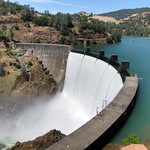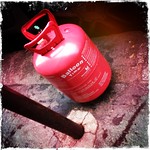5
Prosper Bamara
Energy exists in different forms which are all vital for community development and life in general. The use of energy is always associated with a certain degree of environmental pollution.
Energy resources are of two main categories: Renewable and Non-Renewable.
1. Vocabulary
Renewable energy: energy from renewable resources (water, solar, wind, bioenergy, …)
Clean energy: energy resource with minimal destructive impact on the environment /renewable energy in general
2. Principal types of energy: renewables and non-renewable energy resources
 |
 |
 |
 |
Questions
- What is the difference between renewable and non-renewable energy?
- Give 2 examples of each type.
Consider the table below and reassess the accuracy of your answers to the above question 1 and question 2.
Table 1: Renewable and non-renewable energy
| Renewable energy (from regenerative resources) | Non-renewable energy |
| Geothermal energy (from geothermal resouces) | Fossil fuel in general
|
| Hydro-power | Nuclear energy |
| Solar energy | Thermal energy: main source of electricity in Senegal (use of diesel powered generators to produce electricity) |
Bioenergy
|
|
| Wind energy (énergie éolienne) | |
| Mechanical energy (for productive use): donkeys and horse-drawn carts, manual water pumps, … |
|
N.B.: At the exception of the Republic of South Africa, African countries do not use the nuclear energy resources for electricity generation
3. Energy use and pollution and advantages of the renewable energy resources
Renewable energy resources are generally considered as being “clean energy resources”, owing to their minimal pollution of the environment.
3.1. Non-renewable energy and pollution
| Nuclear | Fossil |
|
|
3.2 Advantages and possible drawbacks (pros and cons) of the renewable energy resources
| Advantages | Possible Disadvantages | |
| 1. Solar energy |
– clean- accessible- under promotion in many parts of the african continent – funds available for promising projects |
– accumulation of e-wastes (electric & electronic wastes, which are difficult to manage) |
| 2. Bioenergy | ||
| Fire wood | – Cleaner than fossil fuels- most accessible for most african people (used by more than 75% of the population in almost all african countries) | – degradation of forests- difficult to control |
| Wood charcoal | – also accessible | – forest destruction |
| Biodiezel and other liquid biofuels | – can be produced from waste livestocks and waste oil in particular- much cleaner than fossil fuels |
– threatening food security (use of edible oil resources)- use of very large masses of land in the case of jatropha plantations for example, …
|
| Hydro-power | – Widely used in Africa- high level of technology mastery | – very low connectivity rate in almost all african countries |
| Geothermal energy | – clean- potential exploitable resource in many parts of the African continent | – highly expensive exploration/prospection phase |
4. Problem: Environmental challenges associated with the use of non-renewable energy and some renewable energy resources (biomass: fire wood, wood charcoal, …)
4.1 Causes
Fossil fuel are up to the present day an essential energy resource and source on which almost all the human activities. It is however associated with a number of negative impacts on the environment, as highlighted in the above paragraphs or tables.
The main cause of the problem stated in the subject is “the human need of a reliable source of energy for life maintenance purposes”.
4.2 Consequences
The consequences associated with using non-renewable resources are diverse:
- emission of green house gases (GHG’s)
- incomplete and complete combustion in motor engines and carburetors, releasing the highly toxic carbon monoxide gas (CO) and the carbon dioxide
- destruction and depletion of forests(fire wood, charcoal, …)
- exposure of land to erosion (due to high speed of deforestation)
- negative impact on the environmental conservation and protection
- negative impact on the species chances to survive as their niches are disturbed and their living environment completely destroyed: risk of extinction of some animal species or migration of animal species to other areas
- threatening plant species lives
- destroying the ecosystems
- negative impact on the tourism industry
- etc.
4.3 Solutions
- Promoting the use of renewable energy resources such as: solar energy, biogas, etc.
- Promoting reforestation or the reduced use of energy resources that lead to forest destruction. Because at a very high rate of such resources usage, the resources may cease to be renewable and become just non-renewable as forests become continuously depleted
- Promoting the use of mechanical energy (for productive use), especially in rural areas and wherever it is feasible (for the donkey-cart or horse-cart), and other mechanical energy resources
- Sensitise the population about the energy use associated consequences of different kind
4.4 Activity (Group activity)
Exercise I: Forming different groups
Exercise II:
- (1) Matching energy resources with type of energy (renewable or non-renewable)
- (2) Matching advantage with energy resource
- (3) Matching consequence with energy resource
Exercise III: Forming debate. Motion: Non-Renewable Energy is more useful than Renewable energy. Choosing a Chairman for the debate (mediating), and two students, one as the supporter and the other as the opposer. They argue, and after each 5 or 8 minutes, the chairman organizes “votes” (raising hands) to see who wins and who has convinced the rest of the class. Then at the end the teacher summerises and thanks the chairman.
N.B.: This exercise can be repeated a number of times, if time allows, and each time a new team of three people may be selected or proposed (why not encouraging people to volunteer), one being the Chairman, the other two oppose and supporter.
Exercise IV: Loooking outside through the window or just by road side for moving cars, and, in groups, drawing a car with visible exhaust gas polluting the environment, the same chart showing usage of fire wood, cooking gas, and forest destruction and a petro station. On a separate chart, show the waterfall and damn, the solar panel, wind energy system, biogas plant.
N.B.: This exercise can take time and the teacher needs to be aware so as to organize the exercise and groups accordingly.
Exercise V/practical: look for some wood and set fire to see exactly what has been drawn and how wood burns (this is to be done outside the class room).
In this scheme, more similar exercises can be proposed by teacher or students can be asked to be creative and be given 10 minutes (or 5 minutes) to come up with a good practicle proposal, as part of the learning.
Exercise VI: Excursion or Field trip/outing at selected sites.
4.5. TIC
Throughout the lesson and exercises, the use of internet will be encouraged whenever possible, and guidance will be provided to students.
Useful websites may be indicated to school girls and boys.
Media Attributions
- EDC

